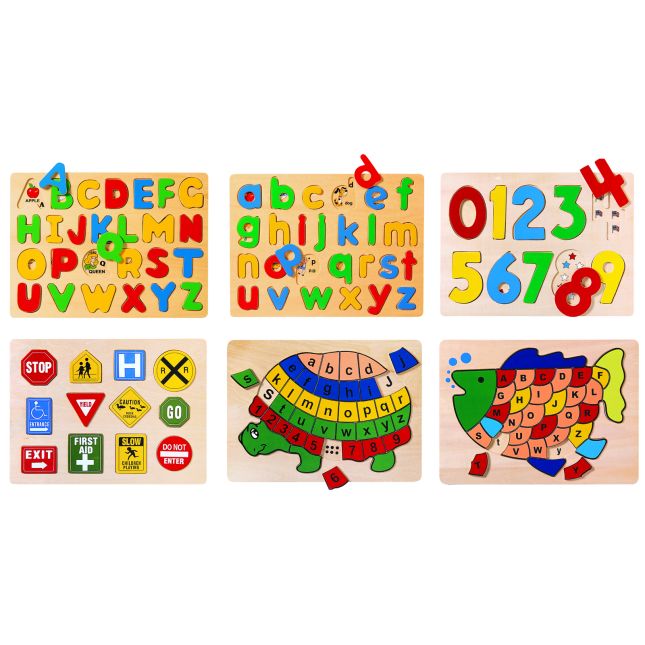The Importance of Puzzles for Toddlers’ Brain Development
Toddler puzzles! Puzzles do wonders for a toddler’s developing brain. Solving puzzles helps toddlers improve their problem-solving abilities. These games encourage little ones to think critically, a key skill for later life. Puzzles also boost hand-eye coordination. Toddlers learn to match shapes and colors, which sharpens their visual perception.

Spatial awareness grows as toddlers figure out where puzzle pieces fit. They begin to understand how different pieces relate to each other in space. This understanding is vital for tasks like reading and writing later on. Moreover, puzzles promote memory development. Remembering shapes, sizes, and solutions allows toddlers to apply this memory in future challenges.
Patience and concentration improve when toddlers work on puzzles. They learn to focus on a task until completion, a valuable trait for any area of life. Lastly, the sense of achievement from solving puzzles can boost a toddler’s confidence. This triumph reinforces their will to tackle new challenges, nurturing a growth mindset from a young age.
In essence, toddler puzzles are about more than just fun. They are building blocks for a child’s cognitive, physical, and emotional development. Choose puzzles wisely and include them in daily play to give your toddler a developmental advantage.

Types of Puzzles Suitable for Toddlers
Choosing the right puzzles for toddlers can be key to their developmental fun. Different types are designed to challenge and delight young minds in a variety of ways. Below are several types of puzzles ideal for toddlers:
- Chunky Puzzles: These puzzles feature thick, easy-to-hold pieces that fit into a wooden board. The chunky pieces are perfect for tiny fingers, making them an excellent choice for beginners.
- Jigsaw Puzzles: Start with simple jigsaws that have a small number of large pieces. As toddlers grow, they can advance to puzzles with more pieces to improve their problem-solving skills.
- Peg Puzzles: Peg puzzles have small pegs on each piece that toddlers can grasp. These puzzles help develop fine motor skills and hand-eye coordination.
- Sound Puzzles: These innovative puzzles make a specific sound when a piece is correctly placed. They add an auditory element to the puzzle-solving experience, stimulating a toddler’s hearing and cognitive association.
- Touch and Feel Puzzles: Sensory puzzles like these encourage toddlers to explore different textures. They can be a fun way for toddlers to learn about various materials and stimulate their tactile senses.
- Shape Sorters: Although not a traditional puzzle, shape sorters teach toddlers to recognize different shapes and colors as they fit the pieces into the correct slots.
- Magnetic Puzzles: Magnetic pieces that stick to a board or fridge offer a unique way for toddlers to solve puzzles and can be especially entertaining for little ones.
Each type of puzzle can help toddlers hone specific skills, from gross motor to sensory awareness. When selecting puzzles, keep in mind your toddler’s developmental stage and interests to ensure an educational play experience. Keeping toddler puzzles in your playtime rotation will engage young minds and give them a strong foundation for future learning.

How to Choose the Right Puzzles for Your Toddler
Choosing the right puzzles for your toddler involves consideration of several factors. Here’s a guide to help you make the best choice for your child:
- Consider Your Toddler’s Age: Pay attention to the recommended age range on the puzzle box. Younger toddlers need simpler puzzles with fewer, larger pieces. Older toddlers can handle more complex puzzles with smaller pieces.
- Look at the Puzzle’s Themes: Pick puzzles with themes that interest your toddler. Themes like animals, vehicles, or favorite cartoon characters can motivate them to play.
- Assess the Complexity: Choose puzzles that are challenging but not too difficult. A puzzle that’s too easy won’t hold their interest, while one that’s too hard may frustrate them.
- Check the Size & Shape of Pieces: Make sure pieces are large enough for small hands to manipulate. Avoid tiny pieces that could pose a choking hazard.
- Select Durable Materials: Toddler puzzles undergo a lot of wear and tear. Choose sturdy materials like thick cardboard or wooden puzzles that can withstand rough play.
- Evaluate Educational Value: Look for puzzles that promote learning, like those that teach shapes, colors, numbers, or letters. These puzzles can be both fun and educational.
- Safety First: Avoid puzzles with sharp edges or toxic materials. Safety should always be a top priority when selecting toys for your child.
By considering these aspects and combining them with knowledge of your toddler’s preferences and abilities, you’ll be able to choose puzzles that are just right for their developmental stage. This will make puzzle time both fun and beneficial for their growth and learning.
Integrating Puzzles into Your Toddler’s Playtime Routine
Integrating puzzles into your toddler’s routine can be simple and beneficial. Here is how to make puzzle time rewarding for your child:
- Create a Regular Puzzle Time: Set aside a specific time each day for puzzles. Consistency helps toddlers anticipate and look forward to their puzzle activity.
- Keep Puzzles Accessible: Place puzzles where your toddler can easily reach them. Having them within sight encourages spontaneous play.
- Encourage Exploration: Allow your toddler to choose which puzzle to play with. This choice gives them a sense of control and engagement.
- Vary the Puzzle Types: Rotate different types of puzzles to keep things fresh. This also exposes your toddler to various skills and learning experiences.
- Play Together: Join in and help your toddler with the puzzles. Your involvement makes the activity more enjoyable and gives opportunities for bonding.
- Celebrate Success: Praise your toddler when they complete a puzzle. Positive reinforcement motivates them to face new challenges.
- Introduce New Puzzles Gradually: Don’t overwhelm your toddler. Introduce more complex puzzles as they master current ones to maintain interest.
- Use Puzzles as Teaching Moments: Use puzzle time to talk about colors, shapes, and themes. This enhances language and cognitive skills.
By incorporating puzzles into everyday play, you create a fun and educational environment. Toddler puzzles can become a cherished part of your child’s playtime, offering both learning and joy.
Recommended Puzzles for Different Toddler Age Groups
When choosing toddler puzzles, consider the developmental milestones typical for different age groups. Here is a handy guide to select age-appropriate puzzles for your little one:
- Ages 1-2: Focus on sensory and discovery puzzles. Large knob puzzles, with simple shapes or farm animals, are perfect. They help toddlers with grip and recognition.
- Ages 2-3: Introduce more complex jigsaws with larger pieces. Peg puzzles are also great. They encourage more precise motor skills and problem-solving.
- Ages 3-4: By this age, kids can manage more detailed puzzles. Think of puzzles with more pieces or puzzles that require sorting by size and color.
- Ages 4-5: Children are ready for advanced jigsaws and can start solving puzzles with up to 50 pieces. Puzzles that depict scenes from stories or daily life can be very engaging.
- Ages 5-6: Challenge them with puzzles having even smaller pieces. Also, interactive 3D puzzles can stimulate spatial reasoning and more complex problem-solving skills.
Selecting the right puzzle for your toddler’s age not only ensures safety but also promotes age-appropriate learning and development. Keep in mind that each child is unique. Watch for cues that they may be ready to advance to the next level of puzzle complexity.
Tips for Encouraging Your Toddler to Solve Puzzles
Encouraging your toddler to engage with puzzles reinforces learning and fosters independence. Try these simple strategies:
- Set a Positive Example: Sit and solve puzzles with your toddler. Your excitement can spark their interest.
- Praise Effort, Not Just Success: Applaud their attempts to solve puzzles. This builds confidence and persistence.
- Start Simple: Begin with easy puzzles and gradually increase difficulty. This approach avoids frustration and keeps them motivated.
- Break it Down: If a puzzle is tough, help your toddler by dividing it into smaller sections.
- Turn it Into a Game: Make puzzle solving a fun game. For instance, time how fast they can complete it or mix pieces from different puzzles and find the right ones.
- Use of Clues: Provide subtle clues to help them find the right piece placement without directly giving the solution.
- Encourage Team Work: Invite siblings or friends for group puzzle-solving. This can make puzzles more exciting.
- Keep it Fun: Ensure puzzle time is always enjoyable. Avoid turning it into a stressful or overly competitive activity.
By using these tips, you can make the process of solving toddler puzzles a more rewarding experience for your child. This not only helps their cognitive development but can also turn puzzle time into an eagerly awaited part of their daily routine.
Safety Considerations When Selecting Toddler Puzzles
Safety is paramount when choosing the right puzzles for toddlers. To ensure a secure play environment, here are some key safety considerations to keep in mind:
- Check for Safety Standards: Look for puzzles that adhere to safety regulations. These products have passed tests for hazardous materials and design safety.
- Inspect Puzzle Pieces: Make sure there are no sharp edges or small parts that could be a choking hazard. The pieces should be too large to fit entirely in a toddler’s mouth.
- Non-toxic Materials: Select puzzles made from non-toxic materials. If your toddler tends to put pieces in their mouth, this is especially crucial.
- Sturdy Construction: Choose puzzles that are well-made and can withstand rough handling. They should not break apart easily, which could create small, dangerous pieces.
- Avoid Magnets: Small magnets can be hazardous if swallowed. If you opt for magnetic puzzles, ensure the magnets are securely embedded.
- Secure Puzzle Boards: Ensure that puzzle boards do not have loose or peeling edges that toddlers might pull off and ingest.
- Age-Appropriate Selection: Only buy puzzles that are designed for your toddler’s age group to limit the risk of injury.
- Regular Checks: Examine puzzles regularly for wear and tear. Repair or discard any that show signs of damage.
By focusing on these safety measures, parents can feel more at ease while toddlers enjoy their puzzle playtime.
Creative Ways to Extend the Play Value of Toddler Puzzles
To keep toddler puzzles exciting and fresh, get creative with how they are used. Here’s how:
- Mix and Match: Combine pieces from different puzzles. It sparks creativity as toddlers figure out what fits where.
- Puzzle Hunts: Hide puzzle pieces around the room for your toddler to find. It turns puzzle time into an adventure.
- Storytelling: Use puzzle images to tell a story. This builds language skills while toddlers solve the puzzle.
- Color & Shape Games: Sort puzzle pieces by color or shape. This simple game reinforces learning of basic concepts.
- Timed Challenges: Introduce a timer for fun. This encourages quicker thinking and adds a playful competitive edge.
- DIY Puzzles: Create homemade puzzles using cardboard. Draw and cut out shapes for a personal touch.
- Reverse Puzzling: Ask your toddler to put the puzzle together in reverse. It’s a novel challenge that promotes problem-solving.
- Puzzle Art: Hang completed puzzles as artwork. It gives a sense of pride and decorates their play space.
By adding these creative twists, toddler puzzles remain a stimulating and enjoyable tool for development.
